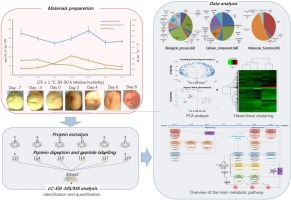当前位置:
X-MOL 学术
›
Postharvest Biol. Technol.
›
论文详情
Our official English website, www.x-mol.net, welcomes your feedback! (Note: you will need to create a separate account there.)
iTRAQ-based quantitative proteomic analysis of peach fruit (Prunus persica L.) at different ripening and postharvest storage stages
Postharvest Biology and Technology ( IF 7 ) Pub Date : 2020-06-01 , DOI: 10.1016/j.postharvbio.2020.111137 Li Jiang , Ruoyi Kang , Li Feng , Zhifang Yu , Haibo Luo
Postharvest Biology and Technology ( IF 7 ) Pub Date : 2020-06-01 , DOI: 10.1016/j.postharvbio.2020.111137 Li Jiang , Ruoyi Kang , Li Feng , Zhifang Yu , Haibo Luo

|
Abstract To better understand the global and dynamic changes in peach (Prunus persica L. cv. Xiahui 8) fruit protein expression, an efficient and reliable proteomic technique, iTRAQ, was used to investigate peach fruit proteome from day -7 to day 8 during storage period at 25 ± 1 °C. A total of 387 proteins with more than 1.2-fold abundance changes were observed. These differentially expressed proteins (DEPs) are mainly related to 17 functional categories. DEPs in day -7 were mainly responsible for sugar and carbohydrate syntheses, protein translation, expression and modification, and maintenance of osmotic balance in high ion and material transport capacities and strong redox reaction environment. Harvesting induced the increase of (small) heat shock protein. Upon harvest, the increased level of respiration rates on day 4 reached the highest level. polygalacturonase (PG), pectase lyase (PL), pectinesterase (PE), chorismate mutase (CM), peptidyl-prolyl isomerase (PPIase) and phytoene synthase (PSY) showed increased abundances and reached a peak at day 6, which significantly positive correlation with 9-cis-epoxycarotenoid dioxygenase (NCED) protein, accelerated fruit softening and metabolism of protein, amino acid and lipid. The emergence of eukaryotic translation initiation factor 5A (EIF5A) on day 8 signified the intensification of apoptosis. Our study facilitated a comprehensive understanding of the complex proteomic reprograming and ripening-associated mechanisms that could be used for endeavors of breeding and postharvest processing to improve peach fruit quality.
中文翻译:

基于 iTRAQ 的桃果实 (Prunus persica L.) 在不同成熟和采后贮藏阶段的定量蛋白质组学分析
摘要 为了更好地了解桃 (Prunus persica L. cv. Xiahui 8) 果实蛋白质表达的全局和动态变化,采用一种高效可靠的蛋白质组学技术 iTRAQ 来研究桃果实在贮藏期间从第 -7 天到第 8 天的蛋白质组。 25 ± 1 °C 期间。总共观察到 387 种蛋白质的丰度变化超过 1.2 倍。这些差异表达蛋白 (DEP) 主要与 17 个功能类别相关。-7 天的 DEP 主要负责糖和碳水化合物的合成、蛋白质的翻译、表达和修饰,以及在高离子和物质传输能力和强氧化还原反应环境中维持渗透平衡。收获诱导(小)热休克蛋白的增加。收获时,第 4 天呼吸频率的增加水平达到最高水平。多聚半乳糖醛酸酶(PG)、果胶酶裂解酶(PL)、果胶酯酶(PE)、分支酸变位酶(CM)、肽基脯氨酰异构酶(PPIase)和八氢番茄红素合酶(PSY)显示丰度增加并在第6天达到峰值,呈显着正相关含 9-顺式环氧类胡萝卜素双加氧酶 (NCED) 蛋白,加速果实软化和蛋白质、氨基酸和脂质的代谢。第 8 天真核翻译起始因子 5A (EIF5A) 的出现标志着细胞凋亡的加剧。我们的研究促进了对复杂的蛋白质组重编程和成熟相关机制的全面了解,这些机制可用于育种和采后加工以提高桃果实质量。果胶酯酶 (PE)、分支酸变位酶 (CM)、肽基-脯氨酰异构酶 (PPIase) 和八氢番茄红素合酶 (PSY) 显示丰度增加并在第 6 天达到峰值,与 9-顺式-环氧类胡萝卜素双加氧酶 (NCED) 蛋白显着正相关,加速果实软化和蛋白质、氨基酸和脂质的代谢。第 8 天真核翻译起始因子 5A (EIF5A) 的出现标志着细胞凋亡的加剧。我们的研究促进了对复杂的蛋白质组重编程和成熟相关机制的全面了解,这些机制可用于育种和采后加工以提高桃果实质量。果胶酯酶 (PE)、分支酸变位酶 (CM)、肽基-脯氨酰异构酶 (PPIase) 和八氢番茄红素合酶 (PSY) 显示丰度增加并在第 6 天达到峰值,与 9-顺式-环氧类胡萝卜素双加氧酶 (NCED) 蛋白显着正相关,加速果实软化和蛋白质、氨基酸和脂质的代谢。第 8 天真核翻译起始因子 5A (EIF5A) 的出现标志着细胞凋亡的加剧。我们的研究促进了对复杂的蛋白质组重编程和成熟相关机制的全面了解,这些机制可用于育种和采后加工以提高桃果实质量。与9-顺式环氧类胡萝卜素双加氧酶(NCED)蛋白显着正相关,加速果实软化和蛋白质、氨基酸和脂质代谢。第 8 天真核翻译起始因子 5A (EIF5A) 的出现标志着细胞凋亡的加剧。我们的研究促进了对复杂的蛋白质组重编程和成熟相关机制的全面了解,这些机制可用于育种和采后加工以提高桃果实质量。与9-顺式环氧类胡萝卜素双加氧酶(NCED)蛋白显着正相关,加速果实软化和蛋白质、氨基酸和脂质代谢。第 8 天真核翻译起始因子 5A (EIF5A) 的出现标志着细胞凋亡的加剧。我们的研究促进了对复杂的蛋白质组重编程和成熟相关机制的全面了解,这些机制可用于育种和采后加工以提高桃果实质量。
更新日期:2020-06-01
中文翻译:

基于 iTRAQ 的桃果实 (Prunus persica L.) 在不同成熟和采后贮藏阶段的定量蛋白质组学分析
摘要 为了更好地了解桃 (Prunus persica L. cv. Xiahui 8) 果实蛋白质表达的全局和动态变化,采用一种高效可靠的蛋白质组学技术 iTRAQ 来研究桃果实在贮藏期间从第 -7 天到第 8 天的蛋白质组。 25 ± 1 °C 期间。总共观察到 387 种蛋白质的丰度变化超过 1.2 倍。这些差异表达蛋白 (DEP) 主要与 17 个功能类别相关。-7 天的 DEP 主要负责糖和碳水化合物的合成、蛋白质的翻译、表达和修饰,以及在高离子和物质传输能力和强氧化还原反应环境中维持渗透平衡。收获诱导(小)热休克蛋白的增加。收获时,第 4 天呼吸频率的增加水平达到最高水平。多聚半乳糖醛酸酶(PG)、果胶酶裂解酶(PL)、果胶酯酶(PE)、分支酸变位酶(CM)、肽基脯氨酰异构酶(PPIase)和八氢番茄红素合酶(PSY)显示丰度增加并在第6天达到峰值,呈显着正相关含 9-顺式环氧类胡萝卜素双加氧酶 (NCED) 蛋白,加速果实软化和蛋白质、氨基酸和脂质的代谢。第 8 天真核翻译起始因子 5A (EIF5A) 的出现标志着细胞凋亡的加剧。我们的研究促进了对复杂的蛋白质组重编程和成熟相关机制的全面了解,这些机制可用于育种和采后加工以提高桃果实质量。果胶酯酶 (PE)、分支酸变位酶 (CM)、肽基-脯氨酰异构酶 (PPIase) 和八氢番茄红素合酶 (PSY) 显示丰度增加并在第 6 天达到峰值,与 9-顺式-环氧类胡萝卜素双加氧酶 (NCED) 蛋白显着正相关,加速果实软化和蛋白质、氨基酸和脂质的代谢。第 8 天真核翻译起始因子 5A (EIF5A) 的出现标志着细胞凋亡的加剧。我们的研究促进了对复杂的蛋白质组重编程和成熟相关机制的全面了解,这些机制可用于育种和采后加工以提高桃果实质量。果胶酯酶 (PE)、分支酸变位酶 (CM)、肽基-脯氨酰异构酶 (PPIase) 和八氢番茄红素合酶 (PSY) 显示丰度增加并在第 6 天达到峰值,与 9-顺式-环氧类胡萝卜素双加氧酶 (NCED) 蛋白显着正相关,加速果实软化和蛋白质、氨基酸和脂质的代谢。第 8 天真核翻译起始因子 5A (EIF5A) 的出现标志着细胞凋亡的加剧。我们的研究促进了对复杂的蛋白质组重编程和成熟相关机制的全面了解,这些机制可用于育种和采后加工以提高桃果实质量。与9-顺式环氧类胡萝卜素双加氧酶(NCED)蛋白显着正相关,加速果实软化和蛋白质、氨基酸和脂质代谢。第 8 天真核翻译起始因子 5A (EIF5A) 的出现标志着细胞凋亡的加剧。我们的研究促进了对复杂的蛋白质组重编程和成熟相关机制的全面了解,这些机制可用于育种和采后加工以提高桃果实质量。与9-顺式环氧类胡萝卜素双加氧酶(NCED)蛋白显着正相关,加速果实软化和蛋白质、氨基酸和脂质代谢。第 8 天真核翻译起始因子 5A (EIF5A) 的出现标志着细胞凋亡的加剧。我们的研究促进了对复杂的蛋白质组重编程和成熟相关机制的全面了解,这些机制可用于育种和采后加工以提高桃果实质量。



























 京公网安备 11010802027423号
京公网安备 11010802027423号